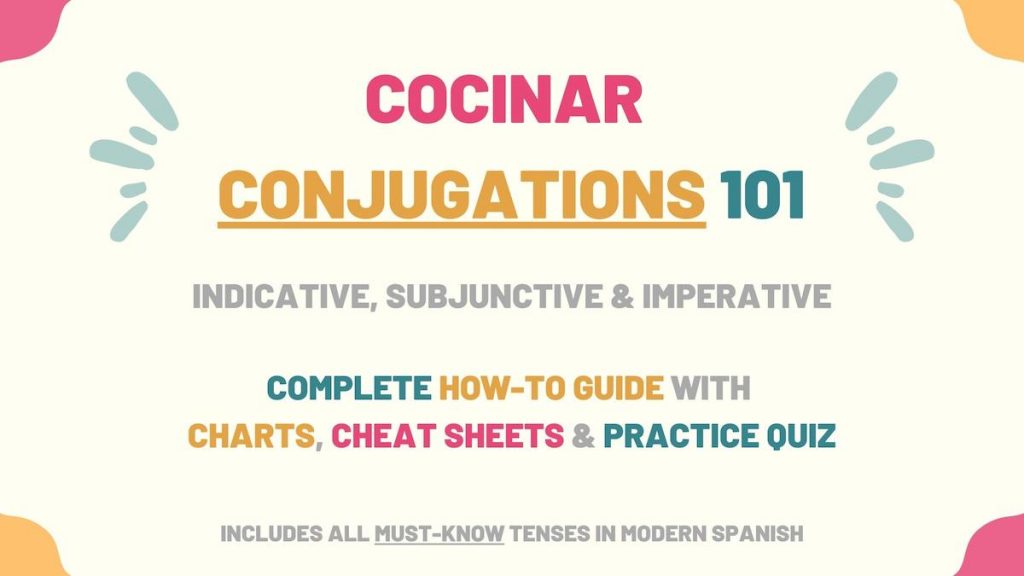Remember that time you were rushing to get ready for a big event, frantically searching for your missing phone while trying to apply mascara with one hand? It’s those moments, fraught with last-minute scrambling, that make “preparar,” the Spanish verb for “to prepare,” feel so relatable. This seemingly simple verb holds the key to organizing your thoughts and actions, both in everyday life and in the world of Spanish grammar.

Image: www.tellmeinspanish.com
So, let’s delve into the intricacies of “preparar,” exploring its conjugations and unlocking the secrets to confidently using this essential Spanish verb. Whether you’re a beginner eager to expand your vocabulary or an advanced learner seeking grammatical precision, this guide will equip you with the knowledge to prepare for any linguistic challenge ahead.
Understanding the Basics of “Preparar” Conjugation
In Spanish, verbs are the heart of the sentence. They convey actions, states of being, and occurrences. Conjugating a verb means adapting its form to match the subject, tense, and mood of the sentence. “Preparar” belongs to the first conjugation, a group of verbs sharing a similar conjugation pattern. While this simplifies the learning process, each verb has its own nuances.
The conjugation of “preparar” follows a structured pattern based on the person and tense. Let’s start with the present tense, which describes actions happening now:
Present Tense Conjugation of “Preparar”
| Person | Singular | Plural |
|---|---|---|
| Yo (I) | preparo | preparamos |
| Tú (You) | preparas | preparáis |
| Él/Ella/Usted (He/She/Formal You) | prepara | preparan |
As you can see, the endings change based on the person – “o” for “yo,” “as” for “tú,” “a” for “él/ella/usted,” and so on. The plural forms follow a similar pattern, using “amos” for “nosotros,” “áis” for “vosotros,” and “an” for “ellos/ellas/ustedes.”
Navigating the Tenses of “Preparar”
Beyond the present tense, “preparar” demonstrates its versatility through its various conjugations. Mastering the common tenses is crucial for expressing actions across different points in time. Here’s a glimpse into some key tenses:

Image: www.teacherspayteachers.com
Preterite Tense: Past Actions
The preterite tense narrates completed actions in the past. It’s used for specific events that happened and are finished. For example, “Preparé la cena anoche” (I prepared dinner last night). The preterite of “preparar” looks like this:
| Person | Singular | Plural |
|---|---|---|
| Yo (I) | preparé | preparamos |
| Tú (You) | preparaste | preparasteis |
| Él/Ella/Usted (He/She/Formal You) | preparó | prepararon |
Imperfect Tense: Ongoing Past Actions
The imperfect tense delves into actions that were happening continuously in the past. It conveys the setting, context, and habits, often in relation to a specific event. For example, “Mientras preparaba la pizza, sonó el teléfono” (While I was preparing the pizza, the phone rang). The imperfect of “preparar” takes this form:
| Person | Singular | Plural |
|---|---|---|
| Yo (I) | preparaba | preparábamos |
| Tú (You) | preparabas | preparabais |
| Él/Ella/Usted (He/She/Formal You) | preparaba | preparaban |
Future Tense: Anticipated Actions
The future tense forecasts events to come, expressing certainty or possibility. It’s used for plans, predictions, and promises. For instance, “Prepararé una fiesta sorpresa para tu cumpleaños” (I will prepare a surprise party for your birthday). The future of “preparar” looks like this:
| Person | Singular | Plural |
|---|---|---|
| Yo (I) | prepararé | prepararemos |
| Tú (You) | prepararás | prepararéis |
| Él/Ella/Usted (He/She/Formal You) | preparará | prepararán |
Using “Preparar” in Context
Understanding the conjugation of “preparar” is just the first step; the real magic happens when you apply it in real-world scenarios. Let’s look at some examples of how “preparar” can be used in various contexts:
“Voy a preparar un delicioso pastel para la fiesta” (I am going to prepare a delicious cake for the party).
“Mi madre preparó una rica cena para toda la familia” (My mother prepared a delicious dinner for the whole family).
“Nos preparamos para el examen final con mucho estudio” (We prepared for the final exam with a lot of studying).
Tips for Mastering “Preparar”
Learning a new verb can feel overwhelming, but remember, practice makes perfect! Here are some tips to expedite your mastery of “preparar”:
- Create a study schedule: Dedicate regular time to practice conjugations.
- Relate to real life: Use “preparar” in everyday contexts, like planning a trip or preparing a meal.
- Practice with flashcards: Create flashcards with the verb forms and their meanings.
- Immerse yourself: Listen to Spanish music, watch Spanish movies, and read Spanish books to encounter the verb in context.
FAQ: Your “Preparar” Questions Answered
Let’s clear up any lingering queries you might have about “preparar”:
Q: Are there any irregular forms for “preparar” in certain tenses?
A: Fortunately, no, “preparar” does not have any irregular forms. It follows a consistent conjugation pattern, making it easier to learn.
Q: How can I remember the different conjugations of “preparar”?
A: Regular practice is key! Create personalized flashcards, use online conjugation tables, and try to incorporate the verb into your everyday conversations.
Q: Are there any related verbs to “preparar”?
A: Yes, there are! You can explore “prepararse” (to prepare oneself), “preparatorio” (preparatory), and “preparado” (prepared) to expand your vocabulary.
Preparar Conjugation
The Takeaway: “Preparar” is Your Spanish Ally
So, there you have it, the essence of “preparar.” From mastering its conjugations to applying it in real-world scenarios, this verb is your key to unlocking confidence in your Spanish proficiency. Remember to practice consistently, immerse yourself in the language, and always seek new opportunities to use “preparar.”
Are you ready to explore other Spanish verbs and continue your language learning journey? Share your thoughts in the comments below!

:max_bytes(150000):strip_icc()/OrangeGloEverydayHardwoodFloorCleaner22oz-5a95a4dd04d1cf0037cbd59c.jpeg?w=740&resize=740,414&ssl=1)




